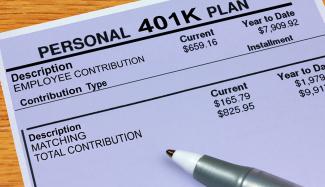
Maximizing Your Employer 401(k) Match
Maximizing your employer’s 401(k) plan match is one of the most important must-do strategies of retirement planning. It really is free money you receive from your employer after you make pre-tax contributions to your retirement plan from your paycheck. If you fail to contribute to your 401(k) plan, you give up the opportunity to receive the employer's matching amount.
Ask your 401(k) plan administrator or an HR representative about your company's match if you haven't received explanatory information on it. If your company offers a match, you probably would have gotten some literature about it; companies typically like to encourage employees to use the match because it fosters loyalty to them as an employer.
Stretching the Match
Keep in mind that an employer matching program is company-specific.
Some employers offer a 100% matching benefit, while others don't match employee contributions at all. Many offer a 50% match.
Some plans may offer a lower percentage match on a higher percentage of the employee's pay—for example, matching 50% on the first 8% of an employee's pay rather than matching 100% on the first 4% of pay—in an effort to encourage greater contributions from the employee. This strategy is called "stretching the match."
However, according to Vanguard's Center for Investor Research, stretching the match does not correlate with higher contribution rates or greater employee participation. Instead, employees were more likely to contribute to a plan if the employer matched 100% of the employees' contributions.2
You might have to work for your employer for a period of time before the company will begin matching your contributions. And some companies make you wait a while—perhaps three or six months or a year—before you can contribute even your own money to its 401(k) plan.
Some Match Examples
A common employee contribution percentage for a 401(k) matching program is 6%. That means when you commit 6% of your pre-tax annual income to the plan, your employer will put its own contribution into your account. Here is an example of how that might work:
- 50% match up to the first 6%: Your employer will place 50 cents into your retirement plan for every dollar you put in, up to 6% of your gross salary for that year. So if you earn $50,000 a year and you contribute at least 6% to your 401(k) plan, you'll receive a matching contribution from your employer of $1,500: 6% of $50,000 is $3,000, and your employer will contribute half that, so you'll have a total of $4,500.
Here is an example in which the employer is generous in terms of the percentage of its match but a little less so in the percentage of your salary it's willing to match:
- Dollar-for-dollar match up to 5%: Your company might contribute a dollar for every dollar you put in your 401(k) plan until you reach a total of 5% of your gross pay for the year. So if you earn $50,000 and you contribute your 5% to the plan—$2,500—your employer will do its 100% match—also $2,500—and you'll have a total of $5,000.
Contribution Dollar Limits
In 2021, the maximum amount you can contribute to your 401(k) plan in dollar terms is $19,500. If you are age 50 or older by the end of the year, your individual limit goes up by $6,500 because you can make a catch-up contribution in that amount. This means your individual limit increases to $26,000.3
The amount of money contributed to a 401(k) account by you and your employer combined in 2020 can not exceed the lesser of:
1) your total compensation
2) $57,000 if you are under 50 years of age or $63,500 if you are 50 or older4
Timing Payments for Maximum Effect
Some employers will pay their match no matter how many paychecks it takes for you to reach your maximum contribution amount for the year. But many companies will make a contribution only during pay periods when 401(k) money is taken from your paycheck. You want to avoid leaving employer money on the table by contributing smaller amounts each pay period, so your employer will make a contribution every period.5
Let's say you're paid two times a month and your employer contributes only when you do. If you reach your $19,500 limit at the end of November, you've missed out on two opportunities for your employer to make its match. (In this scenario, you're earning much more than $50,000 a year.)
Your plan manager can help you optimize your 401(k) contributions to make the most of your employer match. You can also use an online calculator to figure out how much you should ideally contribute from each paycheck.
Vesting Schedule
The money you contribute to your 401(k) plan is yours to keep, no matter when you terminate your employment. However, the contributions made by your employer are probably going to be subject to a vesting schedule.
That means you'll have to work for the company for a specified period of time before you can take your employer's contributions with you when you leave your job.1 If you're close to becoming fully vested in your 401(k), you might want to hold off on that job search for a few more months.
Check out the full article here: https://www.thebalance.com/maximizing-401k-match-2894175

